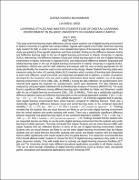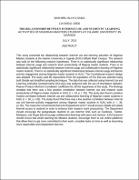Learning styles and master students' use of digital learning environment in Islamic University in Uganda main campus.
Abstract
ABSTRACT
This study examined learning styles differences among master students' use of digital learning environment in Islamic University In Uganda main campus Mbale, Uganda with respect to the Felder-Silverman learning style model (FSLSM), in order to provide a more detailed description of the learning style dimensions. The study was guided by three specific objectives and these included; finding out the difference between Active and Reflective learning styles in the use of digital learning environment in Islamic University in Uganda (IUIU), determining the difference between Visual and Verbal learning styles in the use of digital learning environment in Islamic University in Uganda (IUIU). and analyzing the difference between Sequential and Global learning styles in the use of digital learning environment in Islamic University in Uganda (IUIU). Quantitative method was used for data collection and analysis with the view of being appropriate for the study specifically, the researcher used a cross-sectional survey design. Master Students' learning styles were measured using the Index of Learning Styles (ILS) inventory which consists of learning style dimensions as active and reflective, visual and verbal, and sequential and global and In addition, a number of questions developed by the researcher were also used to gather information about master students’ use of the digital learning environment in IUIU (OBL,CBL, & MMBL). During the data collection, 94 questionnaires were returned back against the expected 111 questionnaires, which were distributed. The data collected was analyzed by using descriptive statistical tool and Multivariate Analysis of Variance (MANOVA). The study found a significant difference among different learning styles identified by Felder and Silveman's model with the use of digital learning environment (OBL, CBL & MMBL). There was a statistically significant difference between active and reflective learning styles on the combined dependent variables: F (3) = 2.133, Sig = .021 < p = .05; Wiki’s Lambda = .652; partial eta squared = .03. Findings suggested that on average, most digital learning environments favor active learners compared to reflective learners. There was a statistically significant difference between visual and verbal learning styles on the combined dependent variables: F (3) = 1.520, Sig = .002< p = .05; Wiki’s Lambda = .447; partial eta squared = .52. Findings revealed that the students who are visual learners are likely to use the entire digital learning environment than the verbal students who prefer studying with words. There was a statistically significant difference between sequential and global learning styles on the combined dependent variables: F (3) = 1.163, Sig = .000< p = .05; Wiki’s Lambda = .616; partial eta squared = .149. Findings revealed that the students who are sequential learners are likely to use the entire digital learning environment than the students who prefer learning in holistic approach. The study concluded that; Master Students who are active learners differ with master students who are reflective learners in terms of the use of digital learning environment. Master Students who are visual learners are likely to use the entire digital learning environment than the Master students who are verbal learners that prefer studying with words, and Master students who are sequential learners differ significantly with master students who are global learners. The researcher recommended that IUIU should allowed master students to choose the form of digital learning experience they prefer in any given classroom activity. This will enable them to actively use digital learning classroom facilities (ICT lab) and The University should make different educational applications accessible to all Master students. This can be done through embedding of digital learning experiences (such as lecture notes, educational games, simulations and educational applications) into the University ERP.
Collections
- Thesis and Dissertations [209]
Related items
Showing items related by title, author, creator and subject.
-
Review of Cloud Computing Framework for the Implementation of eLearning Systems
SADIKI HABIBU ASABA; Adam A . Alli; SURAJUDEEN ADEBAYO OLAWALE; YAHAYA UMAR; ABDALLAH KASULE; RASHID RAMADHAN BWAMBALE (Uganda Higher Education Review journal, 2024-02-05)The rapid growth in Information and Communication Technology (ICT), combined with recent events such as the Covid-19 lockdown, has had a significant impact on traditional educational systems. Today, eLearning has become ... -
Effect of cooperative learning on learners’ English grammar Proficiency in secondary schools in Wuro Juli district, Gombe, Nigeria
Khadijah, Muhammad Nasir (2014)The purpose of this study was to examine the effect of cooperative learning on students, English grammar proficiency in Wuro Juli district. Four research hypotheses guided the study: HO1 cooperative learning has no significant ... -
The relationship between internet use and students’ learning activities of Nigerian masters students at Islamic University in Uganda.
Gada, Bashiru Aliyu (2015)ABSTRACT This study examined the relationship between internet use and learning activities of Nigerian Masters students at the Islamic University in Uganda (IUIU) Mbale Main Campus. The research was built on the following ...




